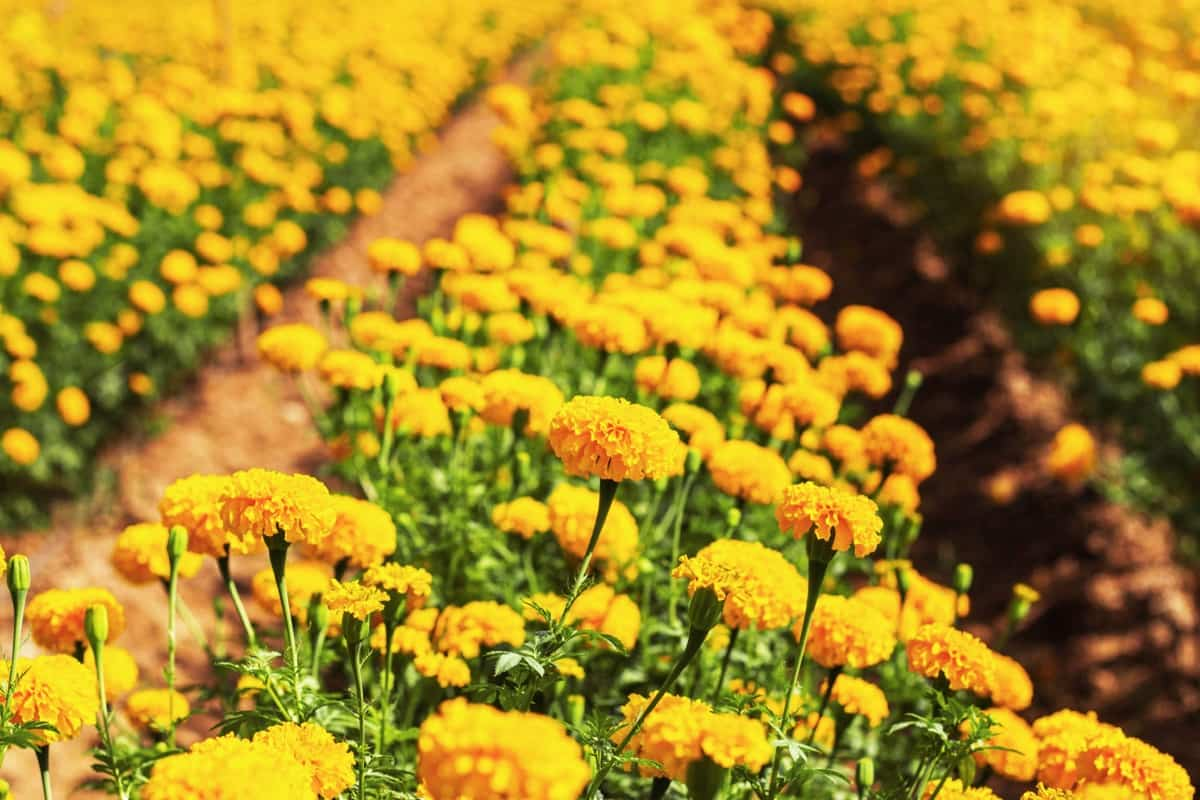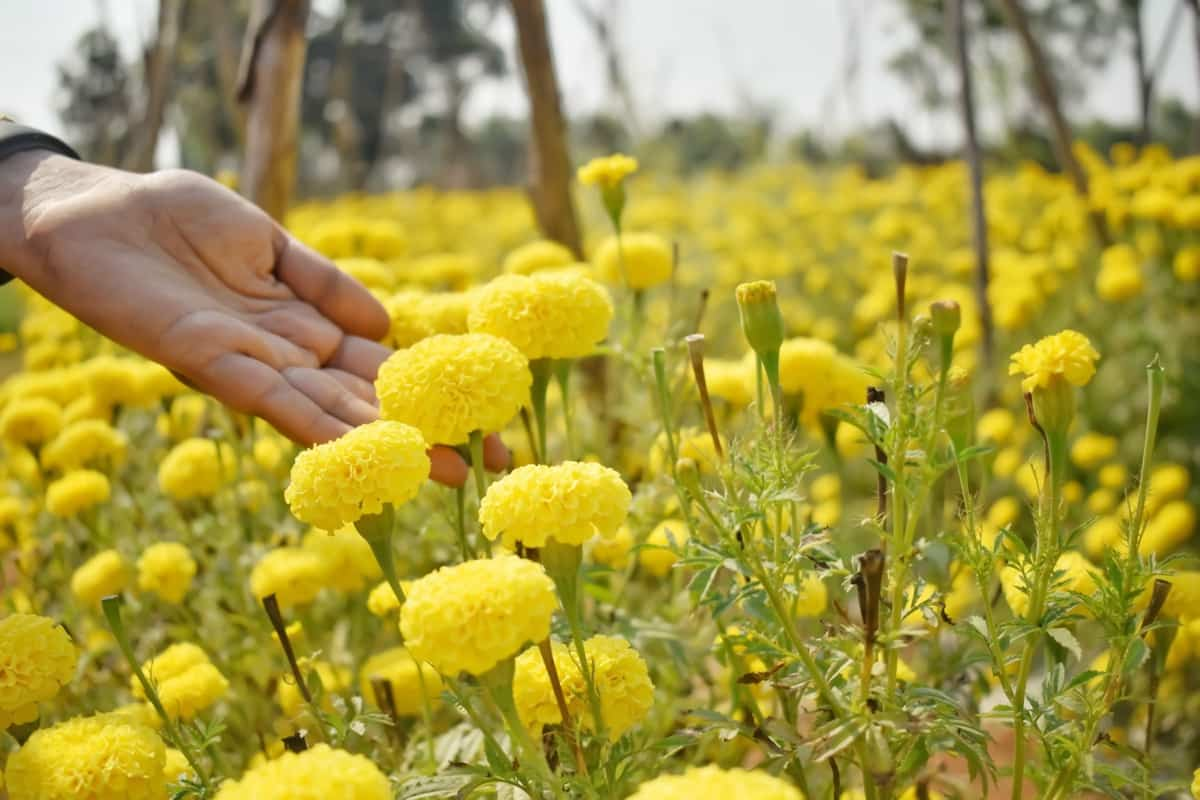In the realm of marigold crop protection, managing insect pests is paramount. To ensure the vibrant blooms thrive, we must tackle the pesky bugs that threaten their beauty. In this brief guide, we’ll unveil the primary insect foes of marigolds and introduce you to the most effective insecticides. Get ready to shield your marigold garden with the power of knowledge and science.

Pest Management in Marigold
What is Pest Management in Marigold?
Marigold, scientifically known as Tagetes erecta L., has deep roots in Chhattisgarh and across India. Originating in Central and South America, particularly Mexico, it journeyed to India in the early 16th century. Today, it thrives so well in Indian conditions that it’s almost considered a native. In Chhattisgarh, marigold reigns supreme in flower cultivation, with 4000 hectares dedicated to its growth, yielding a remarkable 7.30 million tons per hectare.
In 2003-04, marigolds covered 17,600 hectares, producing a whopping 2 lakh metric tons. However, marigold faces their share of challenges, with insect pests like aphids, mites, and thrips among their adversaries. Notably, the Neohydatothrips thrips genus, comprising 103 species, feeds on marigold leaves. The capitulum borer, Helicoverpa armigera, is a polyphagous troublemaker feasting on various crops.
Common Pest in Marigold Crop
Common pests in marigold crops include aphids, caterpillars, whiteflies, and spider mites. Aphids are insects that feed on plant sap, while caterpillars, such as the cabbage looper, devour marigold foliage. Whiteflies are small, white, or silver flies that gather beneath leaves, causing damage. Spider mites infest marigolds, leaving behind webbing and yellow spots. These pests can stunt growth and affect the plant’s overall health.
| Pest Type | Damage Symptoms |
| Aphids | Sap-feeding, black or green bodies, black mold, distorted leaves |
| Caterpillars | Leaf damage, various species including cabbage looper, orange tortrix, and sunflower moth caterpillars |
| Earwigs | Omnivorous, reddish-brown bodies, active at night |
| Leaf Miners | Meandering lines on leaves, small flying insects with black and yellow bodies |
| Slugs and Snails | Young plant or seedling damage, active in wet conditions |
| Spider Mites | White webbing, brown or yellow spots on leaves |
| Thrips | Stippling or silvering of leaves, weaker plants are more vulnerable |
| Whiteflies | Presence beneath leaves, honeydew deposits, black mold, yellowing leaves |
In case you missed it: Weed Management in Quinoa: A Step-by-step Guide

Major Insect Pest Marigold Pests and How to Identify Them
Aphids: Aphids are a prevalent garden pest, known for their small black or green bodies. They feed on sap, typically congregating on the undersides of leaves. Aphid infestations can lead to problems like black mold and distorted leaf growth. To control aphids, consider using a well-aimed hose spray to dislodge them. Alternatively, biological controls, insecticidal soap, and horticultural oils can be effective solutions. Encouraging natural predators of aphids, such as hoverflies, lacewings, or ladybirds, can also help manage these pests.
Caterpillars: Marigolds can attract various species of caterpillars, including the cabbage looper, orange tortrix, and sunflower moth caterpillars. These voracious eaters can damage marigold foliage. To deal with caterpillars, it’s advisable to wear gloves and manually pick them off the plants. Regular weeding around your marigolds can deter caterpillars, as most butterflies and moths lay their eggs on weeds.
Earwigs: Earwigs are omnivorous pests recognizable by their reddish-brown bodies and prominent pincers on their abdomens. They are primarily active at night. To manage earwigs, remove potential hiding spots like fallen leaves and use horticultural oils, insecticidal soap, or homemade traps to eliminate them.
Leaf Miners: Leaf miners use marigolds as host plants for their larvae, which tunnel through marigold leaves, leaving distinctive meandering lines on the surface. These small flying insects with black and yellow bodies are responsible for this damage. Remove infested leaves and apply insecticidal soap or horticultural oils to address leaf miners. Maintaining the health of your marigolds through proper watering can also deter leaf miners.
Slugs and Snails: Slugs and snails are notorious garden pests that prey on young marigold plants and seedlings. They are more active in wet conditions. To combat slugs and snails, manually pick them off and crush them. Implementing traps, such as fruit or beer traps, can also help. Encouraging natural predators like birds, hedgehogs, and frogs can contribute to pest control.
Spider Mites: Spider mites, tiny insects that feed on chlorophyll, can cause damage to marigolds. Infested leaves often display white webbing and brown or yellow spots. Combat spider mites using biological controls, horticultural oils, insecticidal soap, or a strong burst of water from a hose.
Thrips: Thrips, like aphids, feed on marigold sap and can cause stippling or silvering of leaves. Weaker marigold plants are particularly vulnerable to thrip infestations. Control thrips using horticultural oils, insecticidal soaps, or biological measures.
Whiteflies: Whiteflies, small white or silver flies, gather beneath marigold leaves, leading to symptoms like honeydew deposits, black mold, and yellowing leaves. Combat whiteflies with horticultural oils, insecticidal soap, hose dislodgement, or the introduction of predatory mites for biological control.
In case you missed it: Pest Management in Rose Crop: Major Insect Pest of Roses and Best Insecticide for Roses

Do Marigolds Attract Pests?
Marigolds emit a pleasant fragrance that attracts insects, making them a desirable garden addition. However, this scent can deter unwanted visitors and pests like snakes, mice, and specific moths and beetles. Certain plants, like cactuses and hydrangeas, may not complement marigolds well. Aphids can be drawn to marigolds, but not all insects find them appetizing.
Natural Enemies in Marigold Pest Management
In marigold pest management, natural enemies are vital in controlling harmful pests. These allies, including ladybird beetles, predatory bugs, and syrphid flies, help maintain a balanced ecosystem by preying on marigold insect pests. For instance, ladybird beetles are known for their appetite for aphids, while predatory bugs target various garden pests. Syrphid flies assist by feeding on harmful insects. Monitoring and encouraging these natural predators can reduce the need for chemical interventions, making marigold cultivation more environmentally friendly.
How to Keep Bugs from Eating Marigolds
- Prevent Standing Water: Ensure no standing water sources are near your garden, as they attract bugs. Use a sprinkler system in rainy climates and a hose in sunny areas.
- Check for Signs of Overheating: Yellowing leaves indicate excessive heat. Monitor soil pH and moisture levels, inspect leaf litter for disease or insects, and replace unhealthy plants.
- Deal with Ants: Ants can deter grubs but harm your plants. Use natural pest control to remove them if necessary.
- Prevent Spider Eggs: Monitor for spider eggs in the soil, as they can multiply and harm your marigolds. Dig them up and relocate to an undisturbed area.
Other Pest Management Strategies in Marigold Crop
Nutrient Management
To ensure healthy growth, marigold cultivation requires proper nutrient management. In the case of African and French marigolds, it’s recommended to apply 400 kg of nitrogen (N), 200 kg of phosphorus (P), and 60 kg of potassium (K) per hectare. Additionally, 50 tons of farmyard manure (FYM) should be incorporated during field preparation. Nitrogen application should be divided into two or three doses during growth to meet the plant’s changing requirements.
Water and Irrigation Management
The frequency and amount of irrigation needed for marigold cultivation depend on various factors, including soil type and the season. Lighter soils require more frequent irrigation than heavy soils. In sandy loam soil, weekly irrigation is essential from September to March. During the summer months, from April to June, irrigation should be carried out for 4 to 5 days to ensure the plants receive adequate moisture.
Weed Management
Weed control is crucial in marigold production. Manual weeding is typically required 3 to 4 times throughout the growth period in India. Chemical weed control methods are also recommended to keep weed populations in check.
Pest Management
- Red Spider Mite: These mites can infest marigold plants near the flowering stage, giving the plants a dusty appearance. Controlling red spider mites can be achieved by spraying Metasystox 25 E C, Rogor, Nuvacron 40 E C, or Kethone at a rate of 1 ml per liter of water.
- Hairy Caterpillar: Hairy caterpillars can cause damage to marigold foliage. You can control them using Nuvan or Thiodan at 1 ml per liter of water.
In case you missed it: Weed Management in Tea Crop: Common Weeds of Tea Plants and Herbicides Safe for Use on Tea Plants

Disease Management
- Damping Off: This disease, caused by Rhizoctonia solani, results in brown necrotic spots that encircle the radicle, later extending to the plumule. To prevent damping off, treat the seeds with Captan at a rate of 3 g or Carbendazim at 2.5 g per kilogram of seeds before sowing.
- Collar Rot: Collar rot can be caused by various pathogens, commonly Phytophthora sp. and Rhizoctonia solani. It can affect both nursery and mature plants. Prevention methods include soil sterilization and using healthy seedlings.
- Flower Bud Rot: Caused by Alternaria dianthi, this disease primarily affects young flower buds, leading to dry rotting. Regularly spraying the crop with Dithane M-45 at 0.2% is an effective control method.
- Powdery Mildew: Powdery mildew, caused by Oidium sp., manifests as whitish, tiny, superficial spots on leaves, eventually covering the entire aerial parts of the plant with a whitish powder. It can be managed by spraying with Karathane (40 E C) at a rate of 0.5% or dusting with sulfur powder at fortnightly intervals.
Pest Challenges and Management in Marigold Crops
- Aphids: These small insects feed on sap and can distort marigold leaves. To manage aphids, use insecticidal soap horticultural oils or encourage natural predators like ladybirds.
- Caterpillars: Various caterpillar species, such as the cabbage looper, can munch on marigold foliage. Handpicking caterpillars and weeding to deter them are effective control measures.
- Earwigs: Nocturnal earwigs with pincers can target marigold flowers. Eliminate hiding places like fallen leaves and employ insecticidal soap or traps for control.
- Leaf Miners: These small flying insects lay larvae in marigold leaves, leaving distinctive meandering lines. Remove affected leaves and use insecticidal soap or horticultural oils.
- Slugs and Snails: These mollusks can devour young marigold plants. Handpick and crush them or use traps and encourage natural predators like birds, hedgehogs, and frogs.
- Spider Mites: Tiny insects that feed on chlorophyll, leaving webbing and yellow spots. Control spider mites with biological measures, horticultural oils, insecticidal soap, or a strong hose burst.
- Thrips: Thrips feed on marigold sap, causing stippling and silvering of leaves. Use horticultural oils, insecticidal soaps, or biological control measures.
- Whiteflies: Small white or silver flies that congregate beneath marigold leaves. Combat whiteflies with horticultural oils, insecticidal soap, or hose dislodgement.
- Mosquitoes and Fleas: Vinegar can deter these pests; apply it to the soil around marigolds and mix it with water to repel them.
- Ants: Use oil traps to repel ants from marigolds and dig oil-filled holes to deter aphids.
Best Insecticide for Marigold to Control Pest
- Neem Oil: Neem oil is a natural and safe option. Mix 1-2 tablespoons of neem oil in a gallon of water and spray it on marigolds. It helps control aphids, caterpillars, and other pests.
- Pyrethrin-based Insecticides: These are effective against a wide range of pests. Follow the manufacturer’s instructions for dilution and application.
- Insecticidal Soap: Insecticidal soaps like Safer Brand are effective against aphids, whiteflies, and spider mites. Mix 2.5 tablespoons in a gallon of water and apply as a spray.
- Spinosad: Spinosad-based products like Captain Jack’s Dead Bug Brew are useful for caterpillar control. Mix per label instructions.
- Malathion: Malathion is effective against aphids and other insects. Dilute as per the manufacturer’s guidelines.
- Carbaryl (Sevin): Sevin is a broad-spectrum insecticide. Follow label instructions for dilution and application to control various pests.
- Permethrin: Permethrin-based insecticides are effective for controlling caterpillars and other pests. Dilute per label instructions.
- Metasystox: Metasystox is used to control red spider mites. Mix it at a rate of 1 ml per liter of water.
- Nuvan: Nuvan is suitable for hairy caterpillar control. Mix it at a rate of 1 ml per liter of water.
- Dithane M-45: Dithane M-45 helps control flower bud rot. Follow label instructions for dilution and application.
In case you missed it: Best Balcony Plants for Apartments in India: Vegetables, Flowers, and Herbs for Low-light, Full Sun

FAQs Related to Pest Management in Marigold Crop
What are the Major Insect Pests that Affect Marigold Crops?
The major insect pests that commonly trouble marigold crops are aphids, caterpillars, whiteflies, thrips, and spider mites.
How do Aphids Damage Marigold Plants?
Aphids feed on the sap of marigold plants, causing stunted growth, distorted leaves, and sometimes even the growth of black mold on the plant.
What is the Best Way to Control Aphids in Marigold Crops?
You can use horticultural oils, insecticidal soap, or natural predators like ladybirds in your garden to control aphids.
Do Marigolds Attract Caterpillars, and How Can We Deal with Them?
Yes, marigolds can attract caterpillars like the cabbage looper. To deal with caterpillars, remove them by hand and consider weeding your garden to deter them.
What are the Common Signs of Whitefly Infestation in Marigolds?
Whiteflies congregate beneath marigold leaves. Signs of infestation include honeydew deposits, black mold, and yellowing leaves.
How do Spider Mites harm Marigolds, and How Can We Control Them?
Spider mites feed on chlorophyll, causing damage like white webbing and yellow spots on marigold leaves. You can control them using biological controls, horticultural oils, insecticidal soap, or a strong burst of water from a hose.
What are the Recommended Chemical Insecticides for Pest Management in Marigold Crops?
Chemical insecticides like Metasystox, Rogor, Nuvacron, and Nuvan can control specific pests like red spider mites and hairy caterpillars.
In case you missed it: Best Plants to Grow Under Grow Lights in Hydroponics: For Flowers, Herbs, Vegetables, and Fruits

What Should I Do if I Suspect a Disease in My Marigold Plants?
If you suspect a disease in your marigolds, promptly identify the issue and apply appropriate treatments. For example, consider spraying with Karathane or dusting with sulfur powder for powdery mildew to control the disease.
Conclusion
Pest management in marigold crops is essential for healthy plants. The major insect pests include aphids, caterpillars, and whiteflies. To combat these pests, the best insecticides for marigolds are neem oil, pyrethrin-based products, insecticidal soap, and spinosad. Proper pest control ensures thriving marigold plants and beautiful blooms.
- Types of Pesticides Used in Agriculture: A Beginner’s Guide
- Economical Aquaculture: A Guide to Low-Budget Fish Farming
- 15 Common Planting Errors That Can Doom Your Fruit Trees
- How to Make Houseplants Bushy: Effective Tips and Ideas
- Innovative Strategies for Boosting Coconut Pollination and Yield
- Pollination Strategies for Maximum Pumpkin Yield
- The Complete Guide to Chicken Fattening: Strategies for Maximum Growth
- Natural Solutions for Tulip Problems: 100% Effective Remedies for Leaf and Bulb-Related Issues
- Revolutionizing Citrus Preservation: Towards a Healthier, Greener Future
- Natural Solutions for Peony Leaf and Flower Problems: 100% Effective Remedies
- Maximizing Profits with Avocado Contract Farming in India: A Comprehensive Guide
- Natural Solutions for Hydrangea Problems: 100% Effective Remedies for Leaf and Flowers
- The Ultimate Guide to Choosing the Perfect Foliage Friend: Bringing Life Indoors
- From Sunlight to Sustainability: 15 Ways to Use Solar Technology in Agriculture
- The Ultimate Guide to Dong Tao Chicken: Exploring from History to Raising
- The Eco-Friendly Makeover: How to Convert Your Unused Swimming Pool into a Fish Pond
- Mastering the Art of Delaware Chicken Farming: Essentials for Healthy Backyard Flocks
- 20 Best Homemade Fertilizers for Money Plant: DIY Recipes and Application Methods
- How to Craft a Comprehensive Free-Range Chicken Farming Business Plan
- Brighten Your Flock: Raising Easter Egger Chickens for Beauty and Bounty
- How to Optimize Your Poultry Egg Farm Business Plan with These Strategies
- Subsidy for Spirulina Cultivation: How Indian Government Schemes Encouraging Spirulina Farmers
- Ultimate Guide to Raising Dominique Chickens: Breeding, Feeding, Egg-Production, and Care
- Mastering the Art of Raising Jersey Giant Chickens: Care, Feeding, and More
- Ultimate Guide to Raising Legbar Chickens: Breeding, Farming Practices, Diet, Egg-Production
- How to Raise Welsummer Chickens: A Comprehensive Guide for Beginners
- How to Protect Indoor Plants in Winter: A Comprehensive Guide
- Ultimate Guide to Grow Bag Gardening: Tips, Tricks, and Planting Ideas for Urban Gardeners
- Guide to Lotus Cultivation: How to Propagate, Plant, Grow, Care, Cost, and Profit
- Agriculture Drone Subsidy Scheme: Government Kisan Subsidy, License, and How to Apply Online
- Ultimate Guide to Raising Araucana Chickens: Breed Profile, Farming Economics, Diet, and Care
- Bringing Hydroponics to Classroom: Importance, Benefits of Learning for School Students
- Ultimate Guide to Raising Polish Chickens: Breed Profile, Farming Economics, Diet, and Care
- Ultimate Guide to Raising Australorp Chickens: Profile, Farming Economics, Egg Production, Diet, and Care
- Silkie Chicken Farming: Raising Practices, Varieties, Egg Production, Diet, and Care
- Sussex Chicken Farming: Raising Practices, Varieties, Egg Production, Diet and Care